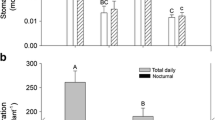Abstract
Numerous studies have demonstrated that physiological responses of many crops to the fraction of extractable soil water conforms to a generalizable pattern. This suggests that differences among crops in their drought tolerance are largely due to differences in the total amount of transpirable water the crop can extract. Potato is frequently assumed to be more drought sensitive than other agronomic crops due, at least in part, to a shallow root system. In the research reported here, potato leaf growth and transpiration response to water deficits were determined as a function of fraction transpirable soil water (FTSW). Transpiration was unaffected by water stress until a critical FTSW was achieved when 64% to 80% of the extractable soil water was depleted depending on the cultivar. This was similar to the response reported for 8 other agronomic crops. In terms of transpiration, potato hypersensitivity to drought stress appears to be due to less effective soil water extraction. Leaf growth, however, showed a unique response to soil water deficits. Leaf growth began to decline when 40% of the extractable soil water was depleted. The associated critical FTSW was higher than any previously reported for all other crops. These data indicate that in addition to extracting less soil water, an additional physiological process related to leaf expansion must be contributing to the potato’s hypersensitivity to drought.
Compendio
Numerosos estudios han demostrado que las respuestas fisiológicas de muchos cultivos a la fracción extraíble de agua del suelo se comporta de una manera posible de generalizarse. Esto sugiere que las diferencias entre sus tolerancias a la sequía son debidas considerablemente a las diferencias en la cantidad total de agua de transpiración que el cultivo puede extraer. Se considera frecuentemente que la papa es más sensible a la sequía que otros cultivos debido, al menos en parte, a un sistema radicular superficial. En la investigación sobre la que aquí se informa, se determinaron las respuestas del crecimiento de las hojas y de la transpiración a los déficits de agua, como una función de la fracción transpirable del agua del suelo (FTSW). La transpiración no fue afectada por el estrés al agua hasta que era alcanzada una FTSW crítica, cuando se consumía del 64% al 80% del agua extraíble del suelo, dependiendo del cultivar. Esto fue similar a la respuesta reportada para otros ocho cultivos. En términos de transpiración, la hipersensibilidad de la papa al estrés a la sequía parece deberse a una extracción menos efectiva del agua del suelo. El crecimiento de las hojas, sin embargo, mostró una respuesta poco común a los déficits de agua en el suelo. El crecimiento de las hojas empezó a declinar cuando se consumió el 40% del agua extraíble del suelo. La FTSW crítica asociada fue mayor que en cualquier otro informe anterior sobre todos los otros cultivos. Esta información indica que además de extraer menos agua del suelo, un proceso fisiológico adicional relacionado a la expansión foliar debe estar contribuyendo a la hipersensibilidad de la papa a la sequía.
Similar content being viewed by others
Literature Cited
Burrows, F.J. 1969. The diffusive conductivity of sugar beet and potato leaves. Agric Meteorology 6:211–226.
Corey, A.T. and G.R. Blake. 1953. Moisture available to various crops in some New Jersey Soils. Soil Sci Soc Am Proc 17:314–317.
Durrant, K.M.J., B.J.G. Love, A.B. Messern and A.P. Draycott. 1973. Growth of crop roots in relation to soil moisture extraction. Ann Appl Biol 74:387–394.
Epstein, E. and W.J. Grant. 1973. Water stress relations of the potato plant under field conditions. Agron J 65:400–404.
Farris, N.F. 1934. Root habits of certain crop plants as observed in the humid soils of New Jersey. Soil Sci 38:87–111.
Fulton, J.M. 1970. Relationship of root extension to the soil moisture level required for maximum yield of potatoes, tomatoes and corn. Can J Soil Sci 50:92–94.
Gandar, P.W. and C.B. Tanner. 1976. Leaf growth, tuber growth and water potential in potatoes. Crop Sci 16:534–538.
Harris, P.M. 1978. Water.In: The potato crop the scientific basis for improvement. P.M. Harris (ed.). Chapman Hall. London.
Jefferies, R.A., 1989. Water-stress and leaf growth in field-grown crops of potato (Solanum tuberosum L.). J Exp Bot 40:1375–1381.
Jefferies, R.A. and D.K.L. Mackerron. 1989. Radiation interception and growth of irrigated and droughted potato (Solanum tuberosum). Field Crops Research 22:101–112.
Leszynski, D.B. and C.B. Tanner. 1976. Seasonal variation of root distribution of irrigated, field-grown russet burbank potato. Am Potato J 53:69–78.
Penman, H.L. 1971. Irrigation at Woburn — VII.In: Rothamsted Experiment Station Report for 1970 Part 2. Rothamsted Experiment Station. Rothamsted.
Ritchie, J.T. 1973. Influence of soil water status and meteorological conditions on evaporation from a corn canopy. Agron J 65:893–897.
Ritchie, J.T., E. Burnett & R.C. Henderson. 1972. Dryland evaporative flux in a subhumid climate. III. Soil water influence. Agron J 64:168–173.
Ritchie, J.T. 1981. Water dynamics in the soil-plant-atmosphere system.In: Plant and Soil Volume 58. Martinus Nijhoff. The Hague. pp 81–96.
Rosenthal, W.D., F. Arkin, P.J. Shouse and W.R. Jordan. 1987. Water deficit effects on transpiration and leaf growth. Agron J 79:1019–1026.
SAS Institute. 1990. SAS user’s guide: statistics. SAS Institute, Cary, NC.
Sinclair, T.R. 1986. Water and Nitrogen Limitations in Soybean Grain Production I. Model Development. Field Crops Research, 15:125–141.
Sinclair, T.R. & M.M. Ludlow. 1986. Influence of soil water supply on the plant water balance of four tropical grain legumes. Aust J Plant Physiol 13: 329–341.
Sinclair, T.R. & R.C. Muchow, J.M. Bennet & L.C. Hammond. 1987. Relative sensitivity of nitrogen and biomass accumulation to drought in field-grown soybean. Agron J 79:989–991.
Van Bavel, C.H.M. 1967. Changes in canopy resistance to water loss from alfalfa induced by soil water depletion. Agr Meteorol 4:165–176.
Author information
Authors and Affiliations
Rights and permissions
About this article
Cite this article
Weisz, R., Kaminski, J. & Smilowitz, Z. Water deficit effects on potato leaf growth and transpiration: Utilizing fraction extractable soil water for comparison with other crops. American Potato Journal 71, 829–840 (1994). https://doi.org/10.1007/BF02849378
Accepted:
Issue Date:
DOI: https://doi.org/10.1007/BF02849378




